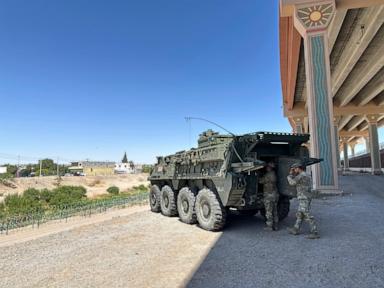COLUMBUS, N.M. — Orange no-entry signs posted by the U.S. military in English and Spanish now dot the New Mexico desert, where a border wall slices through onion fields and parched ranches. These signs mark the expansion of militarized zones along the U.S.-Mexico border, a move that has stirred significant controversy. The U.S. Army has declared these areas as “restricted” under the authority of the national emergency declared by former President Donald Trump.
The expansion places long stretches of the border under military supervision, allowing U.S. troops to detain individuals entering the country illegally. This development sidesteps the Posse Comitatus Act, which traditionally prohibits military involvement in civilian law enforcement. U.S. authorities argue that these zones are essential to closing enforcement gaps and combating human smuggling and drug cartels.
Military Presence and Public Reaction
The establishment of these zones has been met with mixed reactions. In New Mexico’s rural Luna County, residents express a blend of support for enhanced border security and concern over restricted access to public lands. James Johnson, a fourth-generation farmer, supports the military’s role, stating, “We as a family have always been very supportive of the mission, and very supportive of border security.”
Conversely, outdoor enthusiasts and civil rights advocates criticize the move. Ray Trejo, a coordinator for the New Mexico Wildlife Federation, voiced concerns about restricted access to cherished landscapes. “I don’t want to go down there with my hunting rifle and all of a sudden somebody rolls up on me and says that I’m in a military zone,” he said.
Legal Challenges and Humanitarian Concerns
The militarization is currently being challenged in court by civil rights groups and federal public defenders. These parties argue that the military’s new oversight of public land is unprecedented and lacks congressional authorization. Rebecca Sheff, an attorney with the American Civil Liberties Union, warned that this could signal a shift towards a more punitive approach to border enforcement.
Humanitarian groups are also alarmed by the potential impact on migrants. Abbey Carpenter, a leader of a search-and-rescue group, highlighted the danger of restricted access to areas where migrant deaths have surged. “Maybe there are more deaths, but we don’t know,” she said.
Impact on Migrants and Legal Proceedings
More than 1,400 migrants have been charged with trespassing on military territory, facing potential prison sentences. In Las Cruces, New Mexico, migrants appear in court, often struggling to understand proceedings through interpreters. A recent case involved a 29-year-old Guatemalan woman who pleaded guilty to illegal entry, with military trespassing charges set aside due to lack of evidence.
Despite the increased military presence, Border Patrol arrests along the southern border have dropped to the lowest level in six decades. On June 28, the Border Patrol made only 137 arrests, a stark contrast to late 2023 figures.
Historical Context and Future Implications
The militarized zones extend from Fort Hancock, Texas, through El Paso, and into New Mexico, partially encircling the village of Columbus. This area is historically significant, having been the site of Pancho Villa’s 1916 raid. Today, it serves as a crossing point for children with U.S. citizenship attending school in the U.S.
Oversight of these zones is divided between U.S. Army commands in Fort Bliss, Texas, and Fort Huachuca, Arizona. The expansion of military zones raises questions about future border enforcement strategies and the potential for increased military involvement.
As legal challenges continue, the implications of this militarization remain uncertain. The debate over the balance between national security and civil liberties is likely to persist, shaping the future of border policy in the United States.
